Dual deploy conversion for Bobcat Special
By Gene Wolski
2012-04-15
When I originally built the Bobcat Special, I planned to eventually convert it to dual deployment. This build steps through the conversion process.
Bobcat Special - single deploy version prior to conversion:
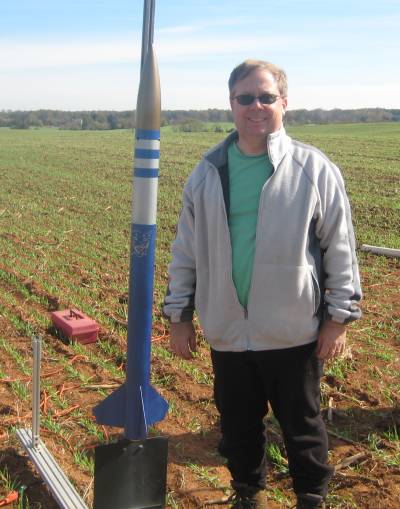
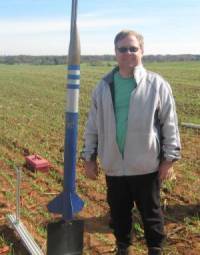
Avionics Bay
2012-04-17
Since the rest of the rocket was scratch built, I decided to make my own avionics bay. I used the following:
- LOC 3" airframe (2" section) for the switch band
- LOC 3" tube coupler (8" total) for the avionics bay body
- LOC 3" tube coupler (7 5/8") for reinforcement
- LOC 3" bulkplate (2)
- LOC 3" coupler bulkplate (1)
- 1/4" allthread (9 1/2")
- 1/4" eye nuts (2) plus regular nuts and washers
- Key switch (1) from Aerocon systems
- Altimeter wiring kit (1) from Dog House Rocketry
- 1/4" launch lug
- plywood altimeter sled
- 4/40 PEM nuts (2) for payload attachment points
I first cut two 4" sections of tube coupler and joined them using the switch band. I then cut sections out of the remaining tube couplers until they fit inside the first tube coupler assembly - spaced evenly from either end. I then mounted a coupler bulk plate to a regular bulk plate for the main/payload end cap. I simply used a coupler bulk plate for the drogue/booster end cap. The threaded rod was cut to length and the eye nuts used to hold this assembly together.
With the body of the avionics bay assembled, I then drilled a hole for the key switch. After soldering the switch lead, I used Gorilla glue to secure the switch and to seal any gaps.
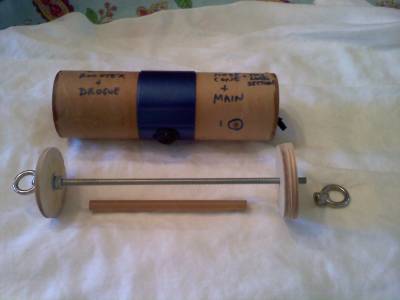

New payload section
2012-04-19
With the avionics bay mostly complete (I'll come back to the altimeter sled and wiring in another post), I moved on to making the new payload section. I started by measuring the shoulder on both the nose cone and the avionics bay. Don't forget to include your eyebolt/attachment point in the nose cone shoulder measurement! To that measurement, I added enough room to hold a chute, shock cord, and chute protector. I then cut and painted the new payload section in the same style as the original. I then mounted the payload section on the avionics bay and drilled clearance holes for 4-40 screws on opposite sides. I then enlarged the holes on the avionics bay and glued 4-40 PEM nuts on the inside to anchor the attachment screws.
New payload section on top - original below:
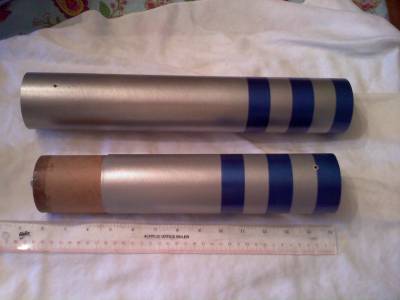
Inside of avionics bay showing one PEM nut attachment point:
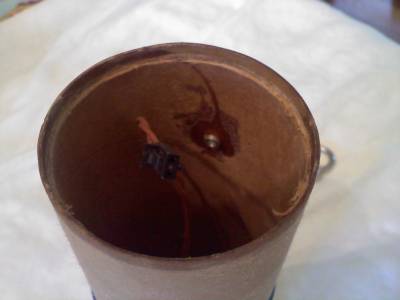

Finished the avionics bay!
2012-10-09
Finally finished the avionics bay and installed the Adept22 using mounting hardware from Adept. I also used their wiring harness but customized the deployment charge ends. One end goes directly to a terminal block and the other goes to a quick disconnect wire. The altimeter powers up nicely using the switch, and a quick vacuum test using christmas tree lights verifies that everything is working as planned. Next step is to install the recovery harness and then ground test.
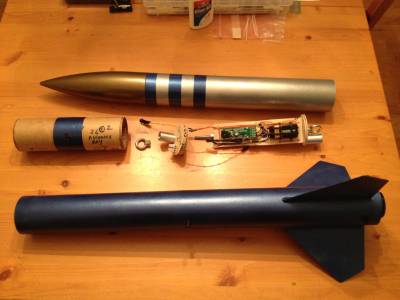
You can also see from the photo that I installed Blastcaps for the ejection charges - I really like these charge holders!

First Flight
2014-03-08
The Bobcat Special finally flew at Battle Park on 3/2/2014. I used an Aerotech I245G reload in at 38/480 case and 38mm Reload Adapter System with one spacer. For ejection charges, I used Quest Q2G2 igniters and black powder in the Blastcaps. I topped off each with a bit of wadding and masking tape to secure the charges.
The launch went really well - great green flame on the I245G, especially on a not so bright day. However, the nose cone popped at apogee (3560ft), and I had a long, long walk (including navigating 3 cow fences) to finally recover the rocket. The neon pink parachute was a lifesaver - I don't think I would've spotted the rocket without it. I did get a 6" zipper in the payload tube (pic to be posted soon), but otherwise the rocket was in great shape.
Lessons learned? Shear pins are your friend! I have them in all of my larger rockets, but I will install shear pins once I cut and fit the new payload section. In hindsight, the nose cone fit was marginal at best.
Sponsored Ads
 |
 |










![Vintage Estes Viper #0820 Model Rocket [4*G-17.25] Vintage Estes Viper #0820 Model Rocket [4*G-17.25]](https://i.ebayimg.com/thumbs/images/g/Q7EAAOSwN1Nl1kDF/s-l225.jpg)
